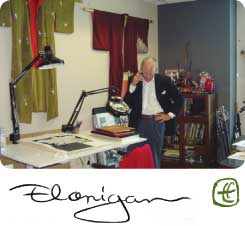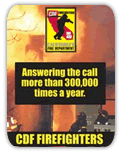Written by Jennifer Goto
Published Issue: Summer 2007
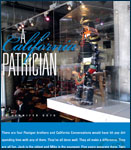 |
His cushioned voice never seems to change much and the lack of inflection comes across as pleasant and patient rather than boring or dismissive. His angular features are cold when he’s silent, yet his smile is genuine, and he warms quickly when he engages you in conversation. Terry has a great, wry laugh, and a knack for looking directly at people and making them feel like whatever they are saying matters, like they matter; he lets people feel important when they are in his company.
Even on a casual day there is an expensive look to Terry’s clothes - a dark blazer with a pocket handkerchief, pressed beige slacks that are just off colored enough not to be mistaken for anything khaki, a blue checkered shirt that is open at the collar, and a watch with an orange band. The slim elegance works well with him. His Jaguar XK8 is immaculate, and he doesn’t say anything in response when someone invariably comments how much they like it. Terry is stylish without any affectation, entitled without any sign of arrogance, graceful, and not apologetic about the great life he’s living.
One of his longtime friends offered an apt description when they said Terry Flanigan is the modern California patrician.
Terrance W. Flanigan, originally Walter Terrance, is a partner with his brothers in the Flanigan Law Firm in Sacramento. He was born in Chicago and moved for reasons of his mother’s health to the better climate of Arizona when he was four-years-old. The family eventually settled in San Diego.
Terry’s mom, Virginia, was a former New York model and his father, Jack, owned a plumbing and heating company, and a Chicago night club.
California Conversations:
Your dad had a plumbing business and ran a night club - rough and tumble upbringing?
Terry Flanigan: Well, that’s not quite accurate. My grandfather was a businessman in Chicago who owned restaurants and some bars, and the flagship of his enterprises was Flanigan’s Plumbing and Heating. So my father was able to go to college, which was not as common for young people then as it is now, and he was a Notre Dame graduate.
CC: Was this in the thirties?
TF: I guess it would have been the late thirties, early forties. My dad was at Notre Dame during the Rockne years and had some great stories about his time in South Bend. He wanted to be a lawyer, but the Second World War broke out and he became what was called a ninety-day wonder - college kids who would spend three months in training and become officers. He took a battery of tests and ended up as a cryptologist. Evidently, he just had a facility for breaking codes and putting codes together.
CC: Did he go back to school after the war ended?
TF: No, his dad passed away, and he took over the family business.
CC: Was his a successful life?
TF: I think so. He did well. I think he was probably frustrated that he didn’t get to finish school and...his life might not have been exactly what he wanted, but he was a very good father and we had a wonderful mother. I think the fact that they wanted to spend time with us made all of us close.
CC: Were you the family that prayed together and stayed together?
TF: (laughs) We were. I think my mom was certainly the one who wanted to make sure that all of us and my dad had religion and experienced Catholicism. Of course, as we got older we probably did not make every Sunday Mass, but I think the religious upbringing was a fundamental part of our being a family.
CC: Did you have a privileged upbringing?
TF: I think it was privileged in some ways. Some people must have believed we were privileged. However, all of us worked. We were expected to work. I joined the box boy union, the retail clerk union in San Diego when I was sixteen and working for Safeway. I worked all the way through college and part of law school.
In 1953, barely old enough for grade school, Terry, his fraternal twin, Tim, and oldest brother, Jack, were sent on weekly visits to a riding stable on the outskirts of Tucson. It was part of his parents’ plan to expose the boys to as many experiences as possible.
The riding instructor and owner of the stable was Pete Martinez, an artist who later became a famous Western genre painter and etcher. Martinez, a former jockey and cowboy, served in the horse cavalry in World War I and in 1935 moved his riding school from Pennsylvania to Arizona.
Terry used his down time at the riding school to learn how to sketch using pencil and charcoal and was changed by the realization that he had artistic talent. Pete told Mrs. Flanigan that Terry showed great promise as an artist, however, the “other brothers should stick to riding horses.”
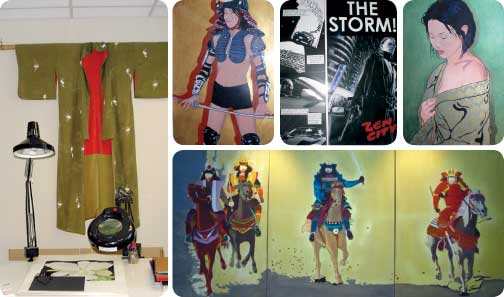
CC: Did Pete Martinez play a role in your life?
TF: Yeah, he did. I remember him quite vividly, and many years later I came across his picture in the Southwest Art Magazine that was featuring artists who specialized in doing horses, and there was Pete Martinez. He was a good artist and my first teacher. I remember a lot about Pete. He’d lost a thumb and, as he explained it to us, he said he’d lost it in a saddle horn when he was doing rodeo. He had this little ranch, and we’d hang around the barn and ride the horses. He became a notable local artist and a good friend of Maynard Dixon, a very well known western artist, and if you go over to the Supreme Court Building across from the Capitol there’s one of the most beautiful rooms in Sacramento. There is a Maynard Dixon mural that runs across the top.
CC: Do you remember the first time you felt artistically inspired?
TF: As a child I remember drawing a picture of a horse, and it struck me that it looked so much like a horse. I was encouraged, and there was good feedback from the people who saw it.
CC: Did it astonish you that you could do it?
TF: I’m not sure I would use the word astonish, but I knew it was special.
CC: Why could you do it? Is it inspiration or is it physical ability?
TF: I think you’re born with the ability to convert an image or a feeling that you have into something tangible for other people to appreciate. I often look at things in terms of shapes, some of that you learn after you’ve actually done drawings and paintings and you develop a sense of shape and perspective. You start looking at things in that fashion.
CC: Did your parents encourage your art?
TF: They did. I think my mother was certainly the most encouraging. I think my dad appreciated it. He thought it was important for all of his sons to become professionals, and anything we did in concert with that was fine.
The challenge to succeed in business and become a person of their time was part of being in the Flanigan household. At San Diego State College, where he was a Speech and Rhetoric major, Terry was elected Student Body President. During his term, he traveled to Sacramento with two of his professors and met with Governor Ronald Reagan. Their task was to lobby changing the official name of the school from San Diego State College to San Diego State University.
CC: You are in your early twenties when you meet Ronald Reagan?
TF: Yeah, it was pretty interesting. It was my first time in Sacramento. I remember the Governor’s outer office was filled with his movie memorabilia, a silver saddle, a couple of hats and a lasso, those sorts of things. We were taken to the back office and the door was opened for us. There’s this guy behind the desk and he’s very soft spoken and he says, “Hi, I’m Ronald Reagan.” I said, yes you are.
CC: Did you like him?
TF: I did. I thought he was everything he appeared to be as I saw him on television.
CC: Which was?
TF: He was nice looking. He looked like a movie star. He was gracious. He was a strong, likeable man.
CC: As a student were you more of a Reagan Republican than an RFK or Eugene McCarthy activist?
TF: Yeah, my mom and dad were Republicans, and I think kids by and large reflect their parents. I seemed to be more conservative then, particularly in 1968 and 1969, close to the height of the Vietnam War. I was more conservative than the activists on campus.
CC: Did you participate in the events of the counterculture?
TF: San Diego State tended to be more conservative than say San Francisco State, but there was still a lot of activity on campus. I would say at the time my general feeling was that it was more appropriate to be taking on the issues of the campus that were student related as opposed to using it as a forum for dealing with Vietnam. I look back now and realize that was not the case. I was wrong. I really think the students made a huge difference during that period in respect to the government dealing with the war.
Terry grew up in what now must seem to be an almost ridiculously wonderful innocence, a time when kids worried about their “permanent record” being marred by a bad grade, or a demerit growing into a black mark that could inhibit the future.
He built an impressive resume of good grades and leadership roles among his peers. He was always chosen first by others, and it was not unexpected that when he graduated from college he would join his brothers in law school.
At the University of California, Terry used his sketching ability to create caricatures of his law professors. It was more fun than rebellious, and the mark-on drawings appeared in the University newspaper with quotes that personified each educator. The pencil drawings were so popular he used them to create a calendar which he sold to faculty and classmates.
Law school, of course, for good or bad, usually means eventually becoming a lawyer. Terry was never reluctant in our conversations to answer questions. He was also not effusive when discussing the early years of practicing law.
Terry served with his brother, Tim, as a prosecutor in the Criminal Division of the Office of the San Diego City Attorney. Afterward, they became partners with city attorney, Dan Bamberg, comprising the San Diego law firm of Bamberg, Flanigan & Flanigan.
CC: Did the Flanigan boys become lawyers because their dad couldn’t?
TF: Maybe, I don’t know. If we did, we don’t have any complaints.
CC: Did you like trial work?
TF: It was satisfying at times.
CC: Good choice for you as a profession?
TF: I look back on it with some satisfaction that as a prosecutor when I took a case to trial it was only a matter of time in terms of getting a conviction. I think in the three years I worked as a prosecutor I only stopped one trial because I wasn’t convinced we had reason to move forward.
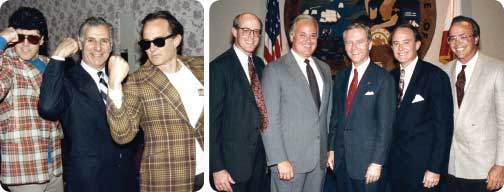
CC: You didn’t do it for long?
TF: No, a couple of years or more and I went into private practice for awhile. Then I went to Europe. I spent about two years doing artwork, and thinking about whether or not I wanted to practice law any more.
Terry’s older brother, Jack, popular, cool, ambitious and a natural born insider was the first intern for a young assemblyman from San Diego named Pete Wilson. Jack’s star rose fast and never settled. Terry followed his brother to Sacramento and began a career as a lawyer/lobbyist representing several organizations, including the California Manufacturers Association and the State Bar of California.
In 1977, while making money and securing an excellent professional reputation, Terry’s restlessness and curiosity prompted him to seek out a particular art teacher.
Terry commuted from his job in Sacramento to San Francisco to attend classes taught by Howard Brodie.
Brodie made his bones in World War II with his poignant drawings of scenes from the front lines at Guadalcanal and the Battle of the Bulge. Not yet thirty when the war started, Brodie became a heralded artist and his pieces were covered regularly by LIFE and LOOK magazines. He would also work in Korea and Vietnam, and become a distinguished sports artist for the San Francisco Chronicle. In the ‘60s, before television was allowed in the courtroom, his drawings set the scene at our country’s most infamous trials: The Chicago 7, Jack Ruby, Manson, and Patty Hearst.
Terry recalled one particular evening in which Brodie was late to class, returning from a trip to Utah. Brodie had a portfolio of sketches he completed of the Gary Gilmore execution. Gilmore, Flanigan recalls, was the first person put to death following the reversal of the federal law banning state executions.
Brodie’s “life” drawing class was important to Flanigan. It helped him to further develop his eye for detail. Although to the pedestrian viewer it appears from his law school sketches that Terry already understood naturalistic body features and facial emotion, he gives Brodie credit for heightening his sensitivity.
After completing the Brodie course, Terry compiled his first professional body of work and offered it for sale in 1979.
Terry chose to link his profession and avocation with a portfolio consisting of several pen and ink drawings depicting famous lawsuits, jury scenes, courtroom figures, and legal concepts.
One of the most popular pieces was a drawing of a young woman and her metamorphosis from law student to attorney to working mother to judge. It is compelling for the simple approach to telling a life’s story. The years are evident in the lines of the woman’s features, a face that evolves without ever losing its truthfulness.
The drawing was described by critics as trend-setting because of its positive view of a woman reaching the pinnacle of success in the male-dominant legal profession.
It was certainly an interesting take thirty years ago for a guy who has brothers and no sisters.
And, then again, maybe not, maybe it has something to do with having a mother who played a big part in the lives of her boys, or maybe he just had a sense that times were changing and he liked progress. Maybe it’s just an indication that a man who enjoyed a long bachelorhood before settling into a happy marriage appreciates women. It certainly marked the beginning of Flanigan using strong women as his subjects.
His dad’s insistence that there be a profession to go in concert with his art was ingrained, probably too deep for Terry to trust making art the complete focus of his energies.
The Flanigans have succeeded in Sacramento. The best lobbyists do well because they’re comfortable with themselves and don’t need the assurances of bright lights. Even now it is interesting to watch Terry take a call and smoothly and calmly work out problems others find daunting.
Before he got rich helping others accomplish what needed to be done, Terry was offered the position of appointments secretary in the administration of George Deukmejian. It is a key job offered by any governor, and he liked the job enough that he stayed on to do the same for Pete Wilson.
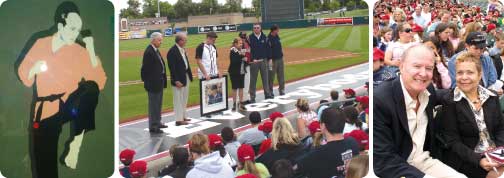
CC: Is your artwork the flip side of your government and lobbying work?
TF: I look at the artwork as being very different than being a lawyer or being in government. It is the right brain-versus-left brain theory that always comes up, but I also think there’s a similarity between what I do artistically that carries over into other parts of my life. Probably one of the better examples, I think, is when I was in trial I would make, in a lot of ways, imagery arguments. I’d speak to people by creating a visuality for them. Lobbying and art share the same creative methodology. A legislative bill and a piece of art both start with a subject matter. In developing the bill one must consider the choice of an author, what language will be used, and a strategy toward the final goal. A piece of artwork has the artist choosing what medium will be used, what message he or she is trying to convey, and how the final work product should appear. And, of course, there are all the similar elements found in the development and execution. What these efforts share in common is the intent to influence the observer.
CC: Are there times when you’re working as a lobbyist that you’re wishing you were working as an artist?
TF: I guess when one does anything professionally you get frustrated and sometimes you’d rather be fishing. So you know, if I’m going to escape somewhere, art is certainly going fishing for me.
CC: I think you’re the only person to serve as the appointments secretary in two administrations. Are you closer to George Deukmejian or Pete Wilson?
TF: Well, I think that’s hard to say. I’m probably closer to Pete, because my family has known him for so long. I’ve known him in more casual conditions than George. But, I felt close to them both. They are both really interesting guys, and I thought they were terrific governors.
CC: Similar in outlook and disposition?
TF: No, not similar in outlook or disposition. I would say they had two very different styles of being governor. George Deukmejian was the consummate administrator. When I worked with him I handled other areas, but I predominantly worked on judicial appointments. George would go through memos and say let’s meet at a certain time and deal with ten appointments, and it would be very businesslike, and he would go home. Pete came into office when there were crisis situations in California, plagues and fires and those sorts of things, and I remember him calling me at 1:00 in the morning. Pete would still be in the office working on something, and when he got to a problem he would focus on it and resolve it. He was not as predictable as George and operated on a looser, broader period of time in terms of getting things done.
CC: Did you ever say, goddammit, Pete, I’m sleeping, call me later?
TF: The short answer is no. But you could say that to him, and he would say something back to you that would be equally obscene.
CC: Great affection for them both?
TF: Yes. Absolutely. I think, I’m sure this happens with anybody in that position, but I’d watch them get negative press for whatever reason, people criticizing them really deep down, and I’d think if their critics were only able to spend the time with them that I did, they’d understand what really interesting and genuine guys they are.
In 1989, the husband of a good friend and co-lobbyist asked Terry to create the artwork for a new Japanese restaurant.
Terry began focusing his attention in the direction of the Japanese world of tradition and mystique. Specifically, Terry looked toward the style of the contemporary artist, Patrick Nagel, who used 17th century Japanese woodblock prints as an inspiration for the use of color in combination with Art Deco styling.
Flanigan replicated Nagel’s process of beginning with a photograph and creating a simplified drawing and translating the drawing to a painting. He then used geometric shapes, creating lines and dimension by juxtaposing dark color against light, and surrounding his female subjects with stark open space.
The paintings confront the viewer. They are startling, sensuous and respectful at the same time. A painting from the collection remains the signature design of the restaurant. More importantly, however, it also affected the direction of Terry’s artistic energy.
One of Terry’s favorite artistic concepts is the study of Japonisme, the influence of Japanese culture on Western European Art. It began in the late 19th century after Commodore Perry was able to make trade routes to Japan available to the outside world.
Terry patiently explains that post-impressionist artist Henri de Toulouse-Lautrec was influenced by Japanese woodblock prints and the arts of ukiyo-e, 17th century prints depicting life of the “floating world.” They defined the pleasures of life in Tokyo via theaters, restaurants, geisha, teahouses, and courtesans.
The Flanigan Law Firm is filled with Terry’s artwork, including a triptych (three panel painting) depicting four samurai warriors on horseback. To commemorate his brother Tim’s achievement at earning his seventh-degree black belt, Terry painted a Japanese woodblock style portrait of him in full garb. It hangs in Tim’s office at the firm.
Terry was approached to create some paintings for a downtown space, which he calls “a private art gallery masquerading as an upscale sushi restaurant.” Of course, women are the subject and each model is depicted in separate paintings, one dressed in the traditional kimono and the other portrayed as a samurai “with a twist.”
Instead of traditional Japanese armor, the women are wearing everyday sports equipment cleverly used to express armor. They are immensely interesting pieces on many levels, approachable and distant at once, as strong as they are beautiful, modern, and ageless.
We also found Terry’s work at a place in Sacramento called Taro’s. The artwork is less traditional to match the exuberant urban Japanese atmosphere. The art pieces at Taro’s are created in the edgy graphic novel style of “Sin City” creator Frank Miller. They are mainly black and white, even a dashing, lively piece of a comic hero, and are favorites of the younger crowd who know Terry’s work. Another favorite is found in a special viewing case in which Terry’s recreated armor of a Samurai is displayed. It is a striking sight, part sculpture and part illusion, and we watched as several people stopped to stare at it and wonder aloud if it was an original from centuries ago.
California Conversations accompanied Terry to the Triple A River Cats Stadium to watch the dedication of a painting Terry did of Emmett Ashford, the first black minor league umpire, that will hang at the ballpark.
He was asked to comment. In his own elegant way he said enough without saying much. Everyone was nodding, expecting him to say more when he smiled and stepped aside. He let the painting of Ashford speak for itself.
The ceremony ended and Ashford’s daughter walked over to look at the painting of her father. “It is him,” she said. “He would have been so proud to know he was being remembered this way.”
We asked Terry his plans for the weekend. He said he was golfing with his brothers.
CC: You’re still close?
TF: Every once in awhile on a Sunday afternoon, the four of us will be playing golf together and we’ll start laughing and say, you’d think we get enough of this during the week.
CC: Is the best ahead of you?
TF: You never know. I don’t have a crystal ball to look into. I don’t know...I’m just taking everything I’ve had up to this point and trying to move it further down the line.